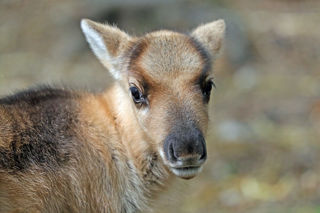
Reindeer
Rangifer tarandus
Reindeer are large members of the deer family, with females reaching 120kg in weight while males, being much larger, can weigh as much as 180kg. When compared to other deer species, their antlers are the largest in relation to body size, and are also grown on both male and females.
Fur colour can vary significantly between individuals, seasons and geography but ranges from grey to dark brown. Their fur has two layers, a dense fluffy underfur, and a longer, hollow overcoat; both layers work together in order to regulate body temperature. Hooves are large and crescent shaped which splay out quite wide, perfect as snow shoes.
Behaviour
Live in large migratory herds of around a few hundred individuals but can form super herds of 50,000 to 500,000 during spring migrations. Migrations are dictated by food sources, normally travelling 19-55km each day. During the rut, males can lose up to 25% of their bodyweight, shed the velvet from their antlers, their necks swell and grow a long mane of hair underneath in order to prepare for fighting.
Within the herds, small harems of females (between 5-15 individuals) are claimed by each victorious male. Reindeer herds can be very vocal communicating with a series of snorts, grunts, growls and hoarse calls. Due to living in the arctic where day and night length can differ substantially from much southerly latitudes, reindeer have lost their circadian rhythm.
UK Status
Reindeer were once found much further south than their current geographical range (as far south as Spain in Europe). Having gone extinct in their native Scotland, Reindeer were reintroduced to the Cairngorm National park in 1952. The total number roaming wild in Scotland now stands at over 150 animals.
Threats
Threats that have affected reindeer populations and their decline are also impacting them today. Climate change, in particular the change in frequency of rain or snow events can seriously affect foraging opportunities which can detrimentally impact reindeer numbers. Parasite and disease prevalence has also been shown to change with warming temperatures.
Habitat changes from forestry and industrial activity (such as roads) lead to changes in vegetation and population fragmentation of reindeer. Hunting and competition with domestic species also poses a problem. Increased pressure from both of these outlets in a barren, harsh environment such as the arctic can have drastic negative effects on population numbers.

Distribution
Found in the most northerly part of the northern hemisphere around the Arctic (such as Norway, Finland, Russia, Canada), but this range has expanded to Iceland and Atlantic islands due to the introduction of domesticated reindeer. The natural range has in fact become fragmented and contracted considerably during the last century.
Habitat
Habitat type can vary considerably, ranging from Boreal forests, arctic polar deserts, tundra, coastal plains and mountain ranges.
Diet
Highly seasonal herbivorous diet. Diet mainly consists of forbs, sedges, grasses, shrubs, mosses, trees and lichens. They select plants that are flowering or have newly unfolded leaves in order to maximise nutritional value in quite a barren landscape.
Family facts
In North America, they are known as caribou, whereas in Europe they are called reindeer.
Whilst both male and female reindeer have antlers, they grow and shed them at different times of the year. Males’ start to grow in February and are shed by November. Females’ begin to grow in May and are not shed until February. This means, the only reindeer to have antlers in December are the females, suggesting that Santa’s reindeer were a team of fully antlered female reindeer pulling his Sleigh on Christmas Eve!
They are the only deer species to have been fully domesticated. First thought to be domesticated by Arctic peoples around 3,000 years ago.
Only known large mammal able to digest lichen due to specialised bacteria in their gut.


